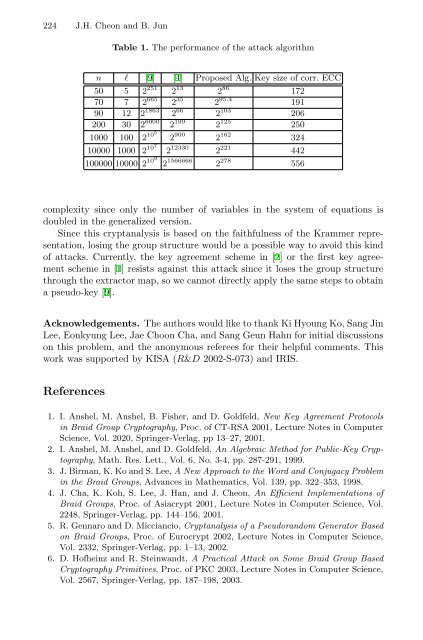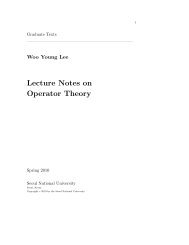A Polynomial Time Algorithm for the Braid Diffie-Hellman Conjugacy ...
A Polynomial Time Algorithm for the Braid Diffie-Hellman Conjugacy ...
A Polynomial Time Algorithm for the Braid Diffie-Hellman Conjugacy ...
You also want an ePaper? Increase the reach of your titles
YUMPU automatically turns print PDFs into web optimized ePapers that Google loves.
224 J.H. Cheon and B. Jun<br />
Table 1. The per<strong>for</strong>mance of <strong>the</strong> attack algorithm<br />
n l [9] [4] Proposed Alg. Key size of corr. ECC<br />
50 5 2 251 2 13 2 86 172<br />
70 7 2 665 2 35 2 95.4 191<br />
90 12 2 1863 2 66 2 103 206<br />
200 30 2 6000 2 199 2 125 250<br />
1000 100 2 105 2 900 2 162 324<br />
10000 1000 2 107 2 12330 2 221 442<br />
100000 10000 2 109 2 1566666 2 278 556<br />
complexity since only <strong>the</strong> number of variables in <strong>the</strong> system of equations is<br />
doubled in <strong>the</strong> generalized version.<br />
Since this cryptanalysis is based on <strong>the</strong> faithfulness of <strong>the</strong> Krammer representation,<br />
losing <strong>the</strong> group structure would be a possible way to avoid this kind<br />
of attacks. Currently, <strong>the</strong> key agreement scheme in [2] or <strong>the</strong> first key agreement<br />
scheme in [1] resists against this attack since it loses <strong>the</strong> group structure<br />
through <strong>the</strong> extractor map, so we cannot directly apply <strong>the</strong> same steps to obtain<br />
a pseudo-key [9].<br />
Acknowledgements. The authors would like to thank Ki Hyoung Ko, Sang Jin<br />
Lee, Eonkyung Lee, Jae Choon Cha, and Sang Geun Hahn <strong>for</strong> initial discussions<br />
on this problem, and <strong>the</strong> anonymous referees <strong>for</strong> <strong>the</strong>ir helpful comments. This<br />
work was supported by KISA (R&D 2002-S-073) and IRIS.<br />
References<br />
1. I. Anshel, M. Anshel, B. Fisher, and D. Goldfeld, New Key Agreement Protocols<br />
in <strong>Braid</strong> Group Cryptography, Proc. of CT-RSA 2001, Lecture Notes in Computer<br />
Science, Vol. 2020, Springer-Verlag, pp 13–27, 2001.<br />
2. I. Anshel, M. Anshel, and D. Goldfeld, An Algebraic Method <strong>for</strong> Public-Key Cryptography,<br />
Math. Res. Lett., Vol. 6, No. 3-4, pp. 287-291, 1999.<br />
3. J. Birman, K. Ko and S. Lee, A New Approach to <strong>the</strong> Word and <strong>Conjugacy</strong> Problem<br />
in <strong>the</strong> <strong>Braid</strong> Groups, Advances in Ma<strong>the</strong>matics, Vol. 139, pp. 322–353, 1998.<br />
4. J. Cha, K. Koh, S. Lee, J. Han, and J. Cheon, An Efficient Implementations of<br />
<strong>Braid</strong> Groups, Proc. of Asiacrypt 2001, Lecture Notes in Computer Science, Vol.<br />
2248, Springer-Verlag, pp. 144–156, 2001.<br />
5. R. Gennaro and D. Micciancio, Cryptanalysis of a Pseudorandom Generator Based<br />
on <strong>Braid</strong> Groups, Proc. of Eurocrypt 2002, Lecture Notes in Computer Science,<br />
Vol. 2332, Springer-Verlag, pp. 1–13, 2002.<br />
6. D. Hofheinz and R. Steinwandt, A Practical Attack on Some <strong>Braid</strong> Group Based<br />
Cryptography Primitives, Proc. of PKC 2003, Lecture Notes in Computer Science,<br />
Vol. 2567, Springer-Verlag, pp. 187–198, 2003.













